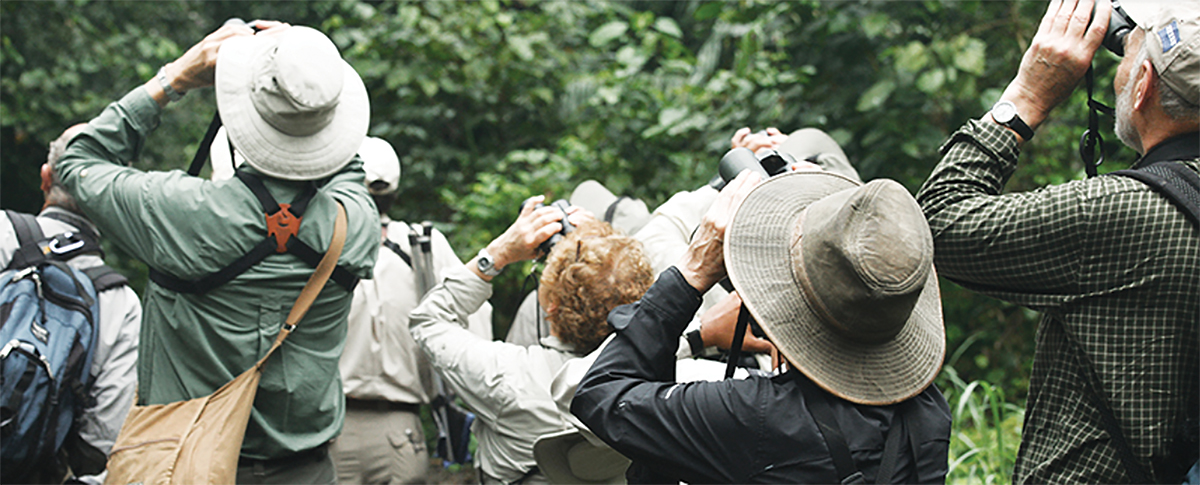WRITER | JULIE FORD
PHOTO | MICHIGANAUDUBON.ORG
Human understanding of where Northern Hemisphere birds go in late fall and why is relatively new. Aristotle and Homer observed seasonal bird changes, but the first scientific proof of migration occurred when a white stork landed in Germany in 1822 with an African spear through its neck. Researchers then began visually tracking bird migrations and recording their findings in notebooks. Today, rapidly changing technology makes migration tracking easier, faster, and instantly communicated to the world.
Bird tracking still requires eyes and ears, but the mechanism for recording the data has changed from handwriting to clicks on a screen. The rudimentary pen and paper method meant the only way other scientists knew about each other’s research was when they shared data at global conferences or read articles in peer-reviewed journals. New research would take weeks or months after compilation to reach fellow researchers and bird enthusiasts in other parts of the world. Once computers became available, handwritten figures were entered into a spreadsheet or database, allowing for less painful tallying and improved accuracy.
Today, the internet has transformed the tracking and sharing of bird migration data with hand-held devices such as tablets and cell phones, and anyone interested in bird watching can enter data. There are many online birding guides to help with identification: Dunkadoo and eBird are useful bird migration apps, and BirdCast is a website that forecasts bird migration.
Dunkadoo
This app isn’t just for bird migration; it can also track species of anything in the natural world. You simply need a Google account for access. Researchers and birders at Michigan’s Whitefish Point Bird Observatory in the Upper Peninsula are using Dunkadoo to record hawks, finches, chickadees, cranes, and myriad other bird species by simply tapping the screen where the bird type is listed. The data can be maintained on personal devices for later use or transmitted to the world – instantly. In addition to being an app, it uses an integrated online data management platform and shares data with organizations such as HawkCount.org.
eBird
eBird is an app created by Cornell University’s Lab of Ornithology. It allows citizen scientists – anyone interested in birds – to enter bird species, habitat, abundance, and distribution data through a system of checklists within an easy-to-understand scientific framework. Checklists are filtered, and if someone enters a sighting of, for example, an Australian wedge-tailed eagle at Quarton Lake in Birmingham, Michigan, a regional eBird expert will challenge the entry. This community-based app was created to gather information from birders and compile it in an easy-to-use app to advance conservation, science, and education, and to make bird watching even more rewarding. More than 100 million bird sightings are entered by eBirders each year from around the world.
BirdCast
Cornell’s Lab of Ornithology also developed BirdCast – a website combining 20 years of bird migration data with real-time meteorological information such as temperature, wind speed and direction, and barometric pressure to forecast bird migration. Its colorful maps display weather information and expected bird migration similar to looking at a weather app and seeing the green, yellow, and orange of an approaching storm. BirdCast uses eBird sightings and weather forecasting data to determine the probability of nocturnal migration throughout the US in real time. Of particular interest in the fall is monitoring when species are expected to depart on their southern migration.
Today’s tools help researchers and birders track and forecast birds on the move. Relying on sight and sound is a major data collection feat that produces solid results, and anyone can do it – especially with advancing technologies. Bird banding is a labor-intensive method with hit-and-miss results, and satellites can track a species with unprecedented accuracy by attaching miniature global positioning system (GPS) devices to individual birds.
Michigan’s coastal areas are especially good birding destinations; in Berrien County, for example, more than 353 species have been recorded. Birding can be a come-as-you-are activity with a pair of basic binoculars or can become quite an investment in equipment. Contact local nature centers and birding clubs to find out where and when to head outdoors to watch Michigan’s birds on the move this fall.
MichiganAudubon.org/go-birding/
Dunkadoo.org
eBird.org
Birdcast.info
Birds.Cornell.edu








